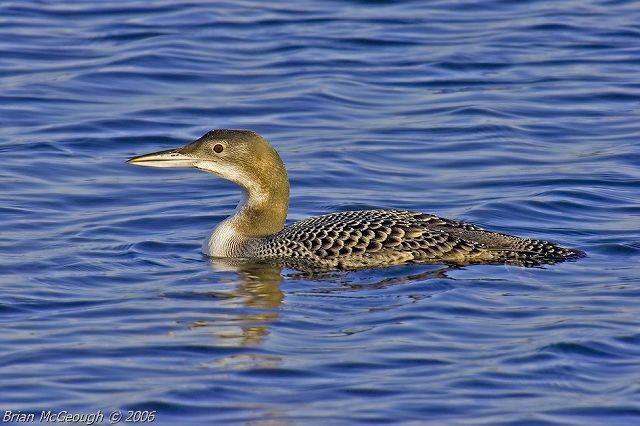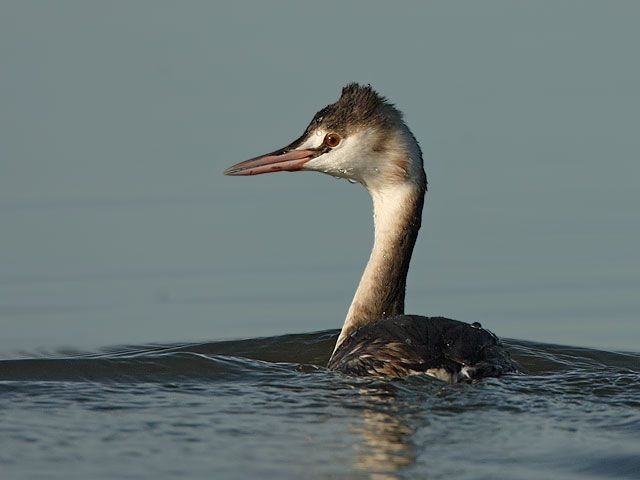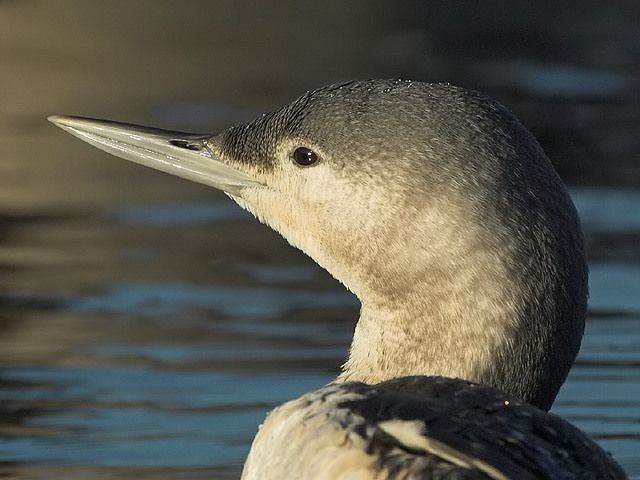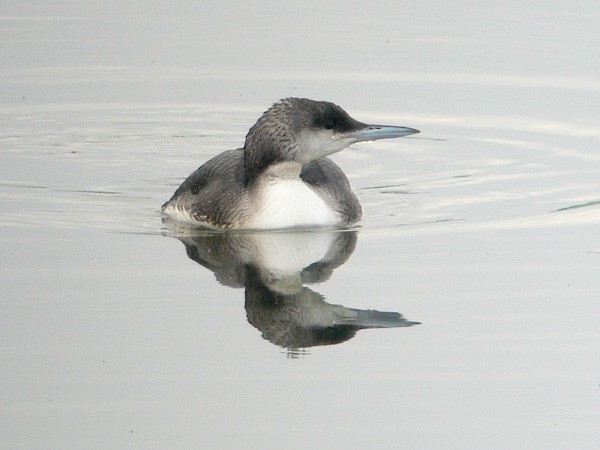
Great Northern Diver: Derbyshire All three species are highly sought after by inland patch-watchers (photo: Brian McGeough) .
Unless they are distant, summer-plumaged divers present little in the way of an identification conundrum. Non-breeding birds can be a different proposition, especially for those who are not used to looking at birds in a coastal setting during the winter months. At this season divers can be found along much of our coastline, but there are other diving species to present a trap for the unwary. Cormorants, auks, grebes and ducks are also present, just to add to the confusion. Grebes and diving ducks on your local gravel pit at close range tend to be relatively straightforward to identify, but put them at distance in a choppy sea and they don't look quite so easy.
The pretenders
Once you've seen your first few divers then you'll wonder why you pondered over whittling them down to one of the three likely species. However, for beginners there are a few hurdles to overcome in this process. Auks and ducks should be readily eliminated. Auks are small, with short necks, and their flight is low to the surface and fast, with whirring wing-beats. Ducks too should present little problem, perhaps only the elongated body of a 'redhead' Red-breasted Merganser inviting possible confusion in a coastal setting. However, they too can be excluded by their lack of contrast between the upper- and underparts and their narrow (saw)bill; in flight they also show white on the wing, a feature exhibited by none of the divers.

Great Crested Grebe: Cheshire Grebes 'sit' high in the water and have a thinner, and longer, neck. Unlike divers the rear-end is 'squared-off' (photo: Steve Round).
Easy so far then? With these two groups eliminated we are left with just grebes and the cormorants. Of the grebes, perhaps only the larger Great Crested Grebe should offer a pitfall, though both Slavonian Grebe and Red-necked Grebe could confuse. To eliminate the grebes look at the rear end, as the grebes have an abrupt, or 'fluffy', cut-off, unlike the sleek rear of the diver. Grebes also sit higher in the water, unlike the low-slung divers, which are also long-bodied in appearance. The grebes have a thinner, and longer, neck though these 'jizz-like' distinguishing features may take a bit of practice before you appreciate their importance fully in the quick dismissal of a grebe as a potential diver species. Try to practise on your local gravel pit or reservoir, where the generally calmer conditions will allow a fuller appreciation of these pitfall species.

Cormorant: Lancs Probably the closest confusion species for the inexperienced. Close-up plumage differences should be obvious, but for distant birds pay attention to the diving action. If you see a half leap and a long tail, then it's either a Cormorant or Shag (photo: Sean Gray).
The trickiest pitfall lies with Cormorant or Shag, both of which can be very diver-like at a distance. Young birds masquerade closest to the genuine article, as they are of a comparable size and have paler underparts. For distant birds paying careful attention to their actions offers the best clue to separating the cormorants from the divers. Both Cormorant and Shag can most easily be mistaken for the Red-throated Diver, which habitually tilts its head sideways in an enquiring manner, in much the same way as the cormorants do (but not grebes). For diving birds, both Cormorants and Shags commence with a half-leap, which then reveals their long tails, whereas divers effortlessly slip into the water and never show any suggestion of that tell-tale long tail.
 |
 |
| Red-throated Diver: Ayrshire Divers often sit up to flap their wings (photo: John Anderson). | Red-throated Diver: Lancashire Although not diagnostic, as grebes can also do it, it might be the first clue to the presence of an offshore diver (photo: Sue Tranter). |
Now that we've narrowed that distant bird to a diver through elimination of the potential confusion families how do we tell each of the diver species from each other?
Red-throated Diver
This is the smallest of the divers, and the most numerous around much of our coastline. The British breeding population, restricted to Scotland, numbers up to 1,500 pairs, and there are a handful of pairs present in Ireland. Estimates of the numbers wintering in British waters vary from 10,000 to as many as 15,000, with perhaps 20,000 present in October.

Red-throated Diver: Norfolk At close range it is easy to observe the uptilted bill. Red-throated Divers habitually tilt their heads sideways in an enquiring manner (photo: Peter Simpson).

Red-throated Diver: Warks Unlike Black-throated there is no isolated flank patch, and the flanks are pale along their length above the waterline. Note also the flat-chested appearance (photo: Steve Seal).
This species represents the 'benchmark diver' for most of us. Learning how to confidently identify a Red-throated Diver outside of the breeding seasons assists in the separation of the two scarcer species. At close quarters Red-throated is a distinctive bird. The upperparts are speckled white, and there is extensive white on the sides of the head and neck. Some white surrounds the eye, leaving the eye more exposed than on the other two species. From behind a narrow dark rear to the neck extends from the nape to the upperparts and much white is evident on the head and neck sides. Unlike Black-throated Diver there is no isolated flank patch, and the flanks are pale along their length above the waterline. At closer ranges, the observer can appreciate the uptilted bill. Structurally it is the smallest of the divers, but not much more so than Black-throated. At d+istance Red-throated appears rather 'flat-chested', unlike the obvious 'chesty' appearance of Black-throated.

Red-throated Diver: Lincs From behind a narrow dark rear to the neck extends from the nape to the upperparts and much white is evident on the head and neck sides (photo: Russell Hayes).
Black-throated Diver
This is a scarce winter visitor and passage migrant, with around 150 pairs breeding in Scotland. The British wintering population is estimated at 1,300 birds.

Black-throated Diver: Lincs Unlike Red-throated the bill is held horizontally, and is dagger-shaped, whilst the forehead is often 'steep' with a peaked forecrown (photo: Russell Hayes).
For many this is the smartest of the divers, Black-throated is a contrastingly 'crisp' species, with a slick appearance. A key feature is the presence of an obvious white flank patch, apparent at quite some distance, whereas the rest of the flanks are dark above the waterline. The upperparts are dark and at least half the neck is white, with little white evident from a rear view. The nape is paler than the back (Great Northern has a darker nape). The eye falls within the dark 'cap', but juvenile Red-throated Diver has a reduced amount of white around the eye, thus inviting confusion by paying too much attention this feature in isolation.

Black-throated Diver: Lincs At least half the neck is white, with little white evident from a rear view. The nape is paler than the back (Great Northern has a darker nape than back) (photo: Paul Sullivan).
Structurally, some individuals can approach Great Northern Diver in size, but there is much overlap between the three species and size comparison is of little use on lone birds. Unlike Red-throated, the bill is held horizontally, and is dagger-shaped, whilst the forehead is often 'steep' with a peaked forecrown and a smoothly rounded hindcrown. A 'curvaceous' species, the posture includes a neatly curved neck and a fuller chest than Red-throated.
 |
 |
| Black-throated Diver: Suffolk A white flank patch is often evident, which can be obvious at quite some distance, whereas the flanks are dark above the waterline (photo: Jack Levene). | Black-throated Diver: Northumberland The head is 'black and white', the eye contained within the darkness (photo: John Malloy). |
 |
 |
| Black-throated Diver: Northumberland Unlike Red-throated the neck is thick and stocky (photo: Alan Gilbertson). | Black-throated Diver: Clyde Note the curve of the head and neck, plus the full-chested appearance (photo: John Molloy). |
Great Northern Diver
The closest breeding grounds lie in Iceland and Greenland. Of the European wintering population of 5,000 birds, 75% occur in the waters of Britain and Ireland, most in northern and western Scotland.

Great Northern Diver: Bedfordshire The contrast between the dark head and neck lacks the clarity of Black-throated and at the base of the neck there is a diagnostic dark half-collar, above which is a pale notch. On juveniles broad pale fringes to the upperparts form a neat scaly pattern (photo: Steve Blain).
A large and powerful species, it invites confusion with Black-throated Diver, but lacks the sophisticated appearance of the latter, often appearing relatively scruffy in comparison.

Great Northern Diver: Cambridgeshire The head is large, with a steep forehead and flat crown. The bill is heavy, and, like Black-throated, held horizontally (photo: Stuart Elsom).
The nape is darker than the back on Great Northern (see Black-throated above) and there is a prominent pale eye-ring. The contrast between the dark head and neck lacks the clarity of Black-throated and at the base of the neck there is a diagnostic dark half-collar, above which is a pale notch. On juveniles broad pale fringes to the upperparts form a neat scaly pattern.

Great Northern Diver: Warwickshire The nape is darker than the back on Great Northern (photo: John Galletly).
Structurally, the head is large, with a steep forehead and flat crown. The bill is heavy, and, like Black-throated, held horizontally.
 |
 |
| Great Northern Diver: Devon A large and powerful species, it lacks the sophisticated appearance of Black-throated, often appearing relatively scruffy in comparison (photo: G. Bullivant). | Great Northern Diver: Cleveland Note the prominent pale eye-ring (photo: Ian Forrest). |
 |
 |
| Great Northern Diver: Somerset Compare the shape of the head with Black- and Red-throated Diver (photo: Oliver Smart). | Great Northern Diver: Cheshire The diagnostic dark half-collar is visible at some distance (photo: Steve Round). |
Flight identification
Seeing a dot on the water and identifying it is one thing; nailing those distant divers passing over the sea is another. All three species can be separated in flight, but as is usually the case this requires practice. To start with you may find that many are best left unassigned. Even proficient seawatchers can't confidently assign very distant birds to species, and some allowance must be made for the conditions, for flight actions vary depending upon the wind speeds.

Cormorant: Fife Don't be tricked in flight. Cormorants are thick-necked and lack the sleek shape of the divers. They also have a less powerful flight, with a flight path interrupted by glides (photo: John Anderson).
As with birds on the water you must first eliminate the confusion species. Grebes show white in the upper-wings and are easily eliminated, as are both Red-breasted Merganser and Goosander. That leaves us with those awkward young cormorants, but a useful hint here is that cormorants flap with glides, whereas divers flap continuously and are strong fliers, often passing at some height to the water.

Red-throated Diver: Warks Note the trailing feet and sleek proportions. They really are quite different to cormorants (photo: Lee Johnson).

Black-throated Diver: Fife The rear of the bird tends to be heavier, with an obvious projection of the feet. The differing proportions tend to 'centre' the wings (photo: John Anderson).
Red-throated is probably the easiest of the trio to identify in flight, thanks to its droopy head and neck, which it appears to struggle to keep up to the horizontal. In addition, they have a habit of moving their head in flight, from side-to-side and even up-and-down. At the 'back-end' the feet appear rather small, whilst the neck appears slim and the back appears 'hunched'. The wing-beats are faster and deeper than Black-throated.

Red-throated Diver: Isle of Man Red-throated often attempts to hold its head above the horizontal, as though a puppeteer is constantly pulling the strings up (photo: Sean Gray).
Black-throated appears thicker-necked in flight than Red-throated, with the neck appearing 'stronger', lacking the 'nodding head' of Red-throated. The bill is held straighter and the searching head movements of Red-throated are almost absent. The rear of the bird tends to be heavier, with an obvious projection of the feet. The differing proportions tend to 'centre' the wings and the wing-beats are slower and shallower.
Great Northern is altogether bigger, and stronger-looking, with a heavy bill, and sturdy horizontal carriage of the head and neck. At the rear it has even larger feet than Black-throated and large toes, adding to the bulky feel of the species. The wing-beats are relatively slow, almost goose-like, with more supple wing-beats.
Something rare: White-billed Diver

White-billed Diver: Orkney Summer-plumaged birds have a strikingly coloured bill; note the straight(ish) culmen and pronounced gonydeal angle, giving the bill a distinctive shape (photo: Steve Evans).
The largest of the divers, there have been well over 250 records of this rare visitor from the high Arctic. Most have been in Scotland, though a fair proportion have penetrated into the North Sea as far as Yorkshire, with records further south decidedly rare. Surprisingly there have been two inland records: an adult at Audenshaw Reservoirs (Gtr Manchester) from 7th to 8th December 1987 and an obliging adult at Tattershall Bridge (Lincs) from 29th February to 2nd March 1996, when it was found moribund; unfortunately it later died. A regular passage of birds has been detected off the Outer Hebrides in recent years, suggesting that small numbers may winter further south in the Atlantic than records imply.
 |
 |
| White-billed Diver: Shetland The head and hindneck are quite pale, as is the area around the eye. Note also the thick neck (photo: Roger Riddington). | White-billed Diver: Shetland The largest of the divers; always pay careful attention to the shape and colour composition of the bill (photo: Roger Riddington). |
The bill is held pointing upwards, hence the reference to 'banana bill'. The bill is yellowish-white, with winter birds showing a darker shade at the base, though perception of colour and shape will depend upon the views obtained. The head and hindneck are paler greyish-brown than the similar Great Northern, and the face is paler, particularly around the eye. This species is a true rarity away from the Northern Isles and Outer Hebrides, so be sure to take careful notes if you suspect that you've found one, or preferably get some pictures!!
They can be very easy!
In summer plumage, and at close range, all three are beautiful, and distinctive, birds.

Red-throated Diver: Highland At close range the dark rufous neck patch is obvious, but at distance this tends to look black. More useful features are the plainly marked upperparts and the pale throat (photo: Ian Fulton).

Black-throated Diver: Argyll The foreneck and throat are black, and the upperparts have obvious white markings (photo: Bill Jackson).

Great Northern Diver: Leicestershire The obvious stripy neck patch and all dark head eliminate Black-throated; note also the white-chequered upper-body markings (photo: John Dickenson).
References
Cramp and Simmons. 2004 Birds of the Western Palearctic interactive. Published by BirdGuides, Sheffield.
Brown and Grice. 2005. Birds in England. Poyser, London.
Svensson, L., Grant, P.J., Mullarney, K., Zetterstrom, D. 1999. Collins Bird Guide. HarperCollins, London.
Birdlife International. 2004. Birds in Europe: Population estimates, trends and conservation status. Cambridge, UK: Birdlife International. (Birdlife Conservation Series No. 12).




